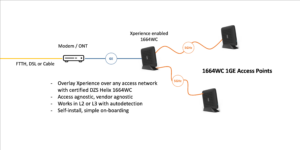The biggest factor in residential subscribers’ perception of service quality is WiFi performance. WiFi complaints represent over half of all support issues while improvements to speeds and services have little impact on the subscriber experience if the in-home WiFi experience is poor. WiFi optimization is the key for service providers looking to manage the total subscriber experience, improve ARPU, cut OPEX and reduce churn.
Traditional tools fall short
As smart devices proliferate, the need for WiFi optimization grows. Traditional routers may enable basic channel selection, but these settings are static. Most devices will automatically contend for the fastest available WiFi channel. This generally reduces overall network performance in the absence of “traffic control.”
In addition, the lack of usage analytics or historical performance metrics leaves home WiFi networks effectively cut off from network management activity, which inevitably leads to hit-or-miss troubleshooting and excessive truck rolls.
Besides having little value for WiFi optimization, traditional WiFi configuration tools are also notoriously difficult for subscribers to use. Very few people will want to point a web browser or look at a bare-bones, device-based GUI.
AI and ML driven real-time WiFi optimization
A superior in-home WiFi experience starts with automation that can optimize those environments , including IoT devices, to ensure wall-to-wall coverage as a foundation for other services.
Each in-home network is unique and complex. In order to deliver the best experience, the most advanced approach available today is to fix connectivity issues in real-time, taking into consideration the type and number of devices in use, their immediate bandwidth needs or priorities and users’ locations within the home, among other things.For example, a Microsoft Teams meeting in progress on a tablet should automatically get higher priority than a Ring doorbell.
Artificial intelligence (AI) and machine learning (ML) can help predict device needs based on analysis of usage patterns. The best WiFi optimization solutions monitor performance for every connected device over time and can learn optimal configurations of the home network. These cloud-based capabilities can dynamically optimize performance for everything, from the latest WiFi 6 or 6E devices, to legacy equipment that may reside on the network for years to come.
Easy subscriber self-service is also essential for a high-quality experience and reduced OPEX . Subscribers expect a mobile app that supports basic WiFi network configuration backed by a high degree of automation, including advanced capabilities that can automatically and continually refine performance.
Owning the WiFi experience pays off
Service Providers who were early adopters of WiFi optimization solutions are experiencing compelling bottom-line benefits, including:
- Monthly residential ARPU increases of $15 or more per subscriber, yielding 200% ROI or more
- Over 67% faster time-to-market for new services
- 51% reduction in support calls, 67% reduction in truck rolls and $150 average savings on installation costs
- 60-point increase in the Average Net Promoter Score (NPS)
- 30% reduction in churn

Tying it all together
DZS Helix WiFi ONTs and Access Points, combined with DZS Xperience, delivers comprehensive manageability and visibility from the cloud to the access edge to the in-home network, enabling service providers to optimize Quality of Experience metrics, increase revenue and lower costs.
This self-optimizing, whole-home WiFi technology uses AI and machine learning to create flawless connectivity across client types, living spaces, as well as complex environments. When combined with standards-based DZS Cloud analytics, orchestration and service management, operators can extend the managed access network all the way to the WiFi connected devices in the home.
To take the first step towards optimizing your subscribers’ in-home WiFi experience, contact DZS.


